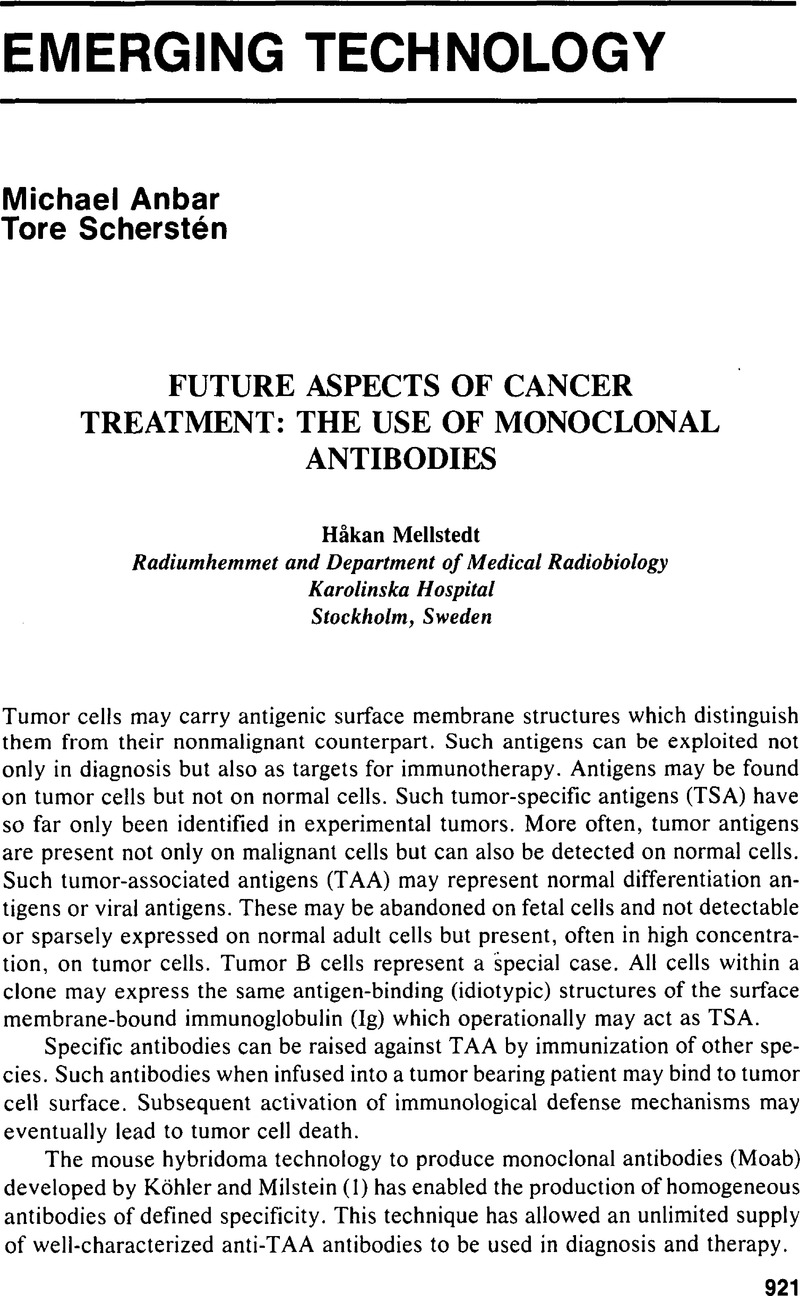No CrossRef data available.
Future Aspects of Cancer Treatment: The Use of Monoclonal Antibodies
Published online by Cambridge University Press: 10 March 2009
Abstract
An abstract is not available for this content so a preview has been provided. Please use the Get access link above for information on how to access this content.

- Type
- Emerging Technology
- Information
- International Journal of Technology Assessment in Health Care , Volume 1 , Issue 4 , October 1985 , pp. 921 - 926
- Copyright
- Copyright © Cambridge University Press 1985
References
REFERENCES
1.Köhler, G., & Milstein, C.Continuous cultures of fused cells secreting antibody of pre-defined specificity. Nature, 1975, 256, 495–497.CrossRefGoogle Scholar
2.Miller, R. A., Maloney, D. C, Varnke, R., & Levy, R.Treatment of B cell lymphoma with monoclonal anti-idiotype antibody. New England Journal of Medicine, 1982, 306, 517–522.CrossRefGoogle ScholarPubMed
3.Koprowski, H., & Herlyn, M. Human tumor antigens. In Wahren, B. (ed.), Progress in cancer research. New York: Raven Press, 1985, 123–139.Google Scholar
4.Schroff, R. W., Farrell, M. M., Klein, R. A., Oldham, R. H., & Foon, K. A.T65 antigen modulation in phase I monoclonal antibody trial with chronic lymphocytic leukemia patients. Journal of Immunology, 1984, 133, 1641–1648.CrossRefGoogle ScholarPubMed
5.Stevenson, F. K., Glennie, M. J., Johnston, D. M. M., Tutt, A. L., & Stevenson, G. T.Consumption of monoclonal anti-idiotypic antibody by neoplastic B lymphocytes: A guide for immunotherapy. British Journal of Cancer, 1984, 50, 407–413.CrossRefGoogle ScholarPubMed
6.Oldham, R. H., Morgan, A. C., Woodhouse, C. S., Schroff, R. W., Abrams, P. G., & Foon, K. A.Monoclonal antibodies in the treatment of cancer: Preliminary observations and future prospect. Medical Oncology & Tumour Pharmacotherapy, 1984, 1, 51–62.CrossRefGoogle Scholar
7.Koprowski, H. Mouse monoclonal antibodies in vivo. In Boss, V. D., Langman, R., Trowbridge, I., & Dulbecco, R. (eds.), Monoclonal antibodies in cancer. New York: Academic Press, 1983, 17–37.Google Scholar
8.Hamblin, T. J., Abdul-Ahad, A. K., Gordon, J., Stevenson, F. K., & Stevenson, G. T.Preliminary experience in treating lymphocytic leukemia with antibody to immunoglobulin idiotypes on the cell surfaces. British Journal of Cancer, 1980, 42, 495–502.CrossRefGoogle ScholarPubMed
9.Steplewski, Z., Lubeck, M. D., & Koprowski, H.Human macrophages armed with murine immunoglobulin G2a antibodies to tumors destroy human cancer cells. Science, 1983, 221, 865–867.CrossRefGoogle ScholarPubMed
10.Akiyama, Y., Lubec, M. D., Steplewski, Z., & Koprowski, H.Induction of mouse IgG2a – and IgG3-dependent cellular cytotoxicity in human monocytic cells. (U937) by immune interferon. Cancer Research, 1984, 44, 5127–5131.Google ScholarPubMed
11.Koprowski, H., Herlyn, D., Lubec, M. D., DeFreitas, E., & Sears, H. F.Human anti-idiotype antibodies in cancer patients: Is the modulation of the immune response is beneficial for the patient? Proct Natl Acad Set, 1984, 81, 216–219.CrossRefGoogle ScholarPubMed
12.Berd, D., Mastrangelo, M. J., Engström, T. F., Paul, A., & Maguire, H.Augmentation of the human immune response by cyclophosphamide. Cancer Research, 1982, 42, 4862–4862.Google ScholarPubMed
13.Uhr, J.Immunotoxins: Harnessing nature's poisons. Journal Immunology, 1984, 133, i–x.CrossRefGoogle ScholarPubMed
14. A report from the Hammersmith Oncology Group and the Imperial Cancer Research Fund: Antibody-guided irradiation of malignant lesions: Three cases illustrating a new method of treatment. The Lancet, 1984, i, 1441–1443.CrossRefGoogle Scholar


